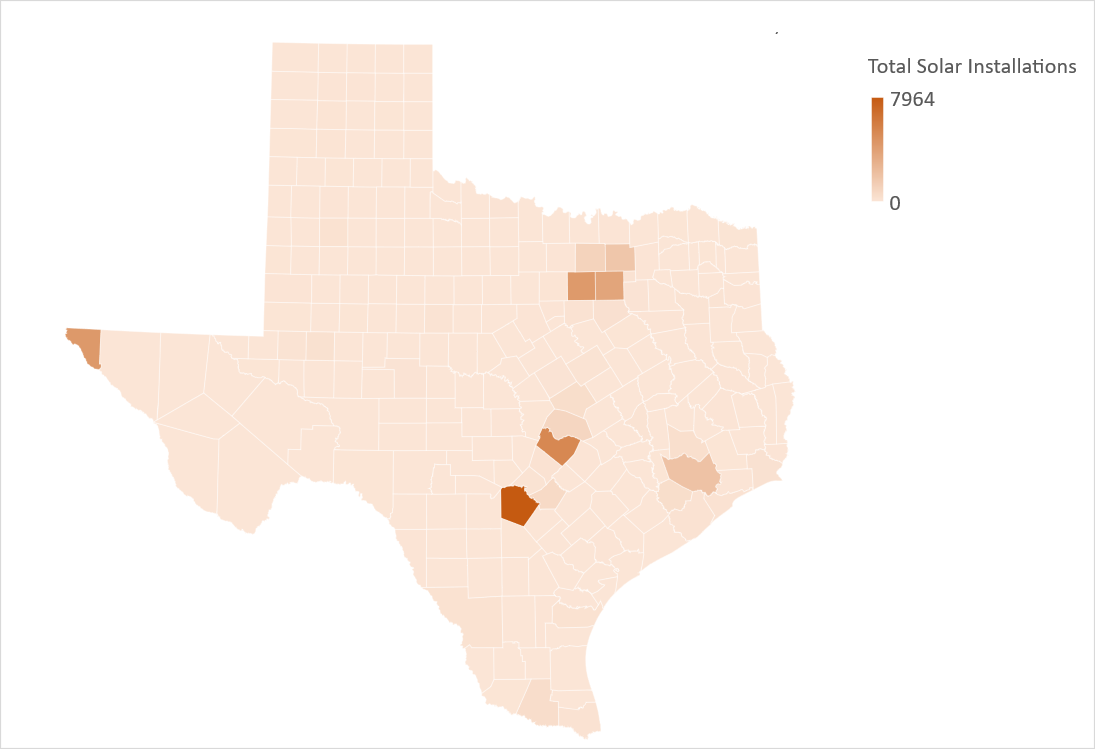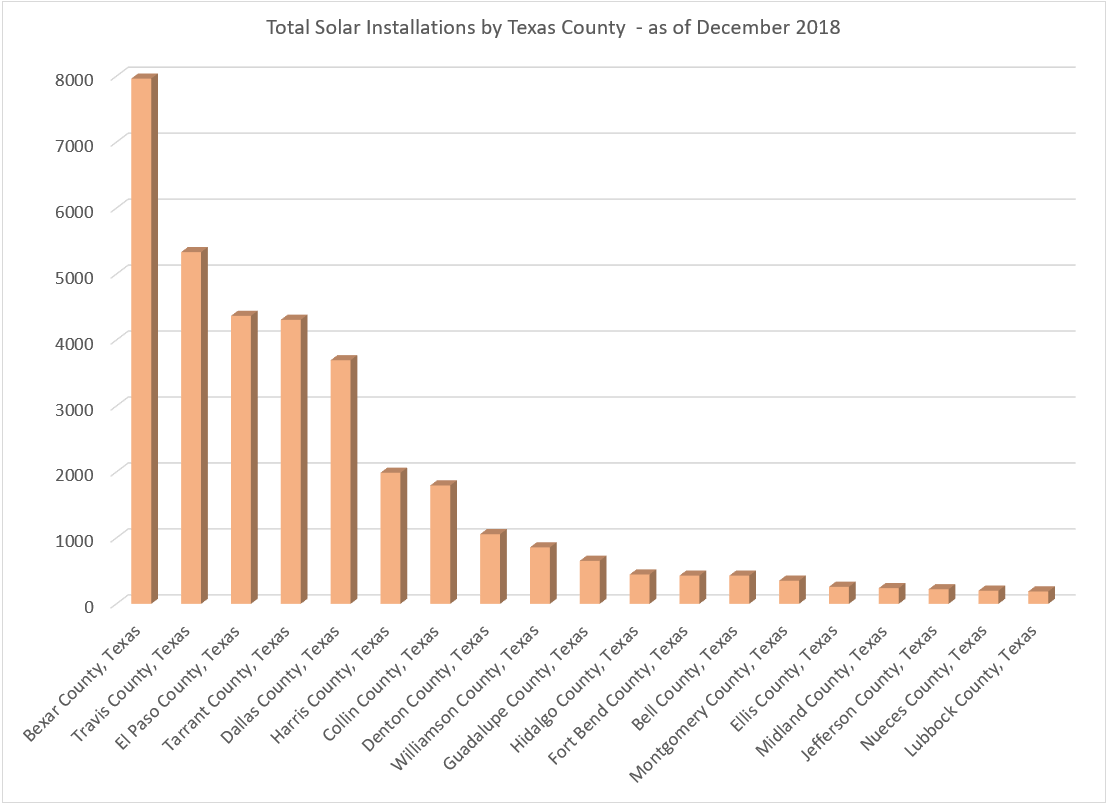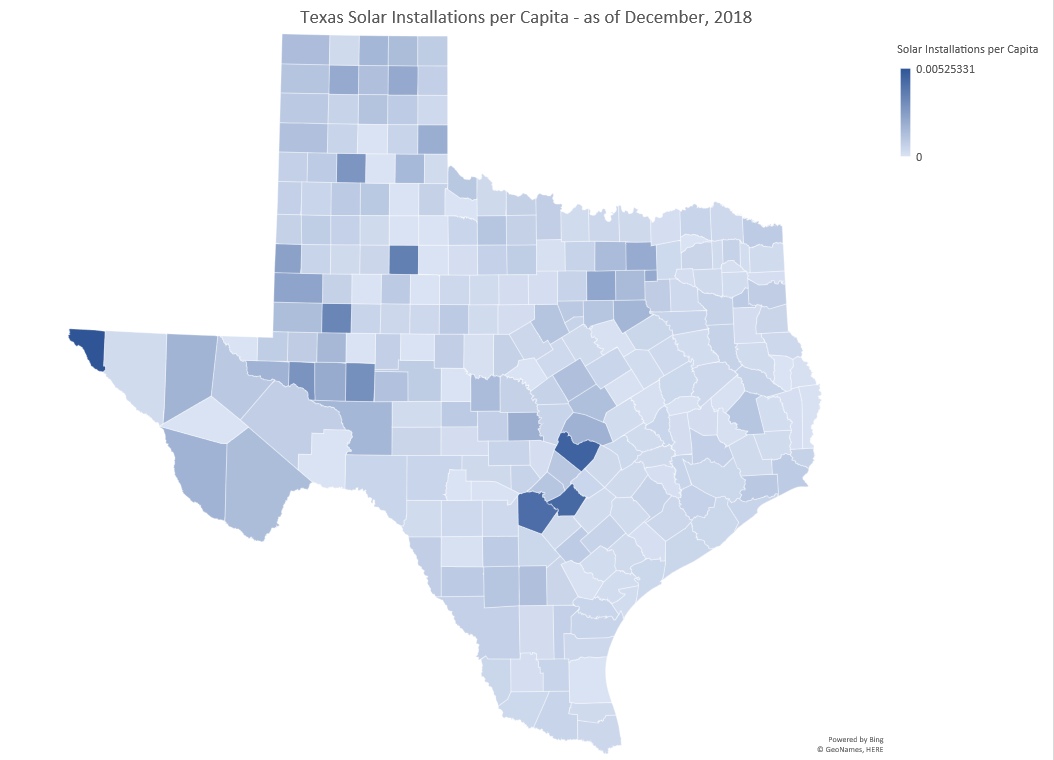Solar Installations in Texas – Bright Spots in the Lone Star State
Regional residential solar growth is picking up across select regions in Texas
Florida may be known as the Sunshine State, but that moniker should perhaps have been reserved for Texas. The Lone Star State typically conjures up images of oil barons and drilling rigs, but petroleum is far from the state’s only natural resource. With its relatively dry climate and southern location, Texas is practically drenched in sunlight. When it comes to taking advantage of this abundant resource, however, the situation becomes decidedly murky.
A Solar Superstar in Potential
At nearly 270,000 square miles, Texas is the largest state in the contiguous United States. It also ranks among the most sun-soaked states, receiving more hours of direct sunlight on average than all but five other states. Considering much of Texas is also relatively flat, dry and lacking in dense vegetation, it should come as no surprise that the state holds extraordinary potential for solar power generation. In fact, the National Renewable Energy Laboratory estimates that Texas far outpaces every state except California in terms of the total potential for rooftop solar production.
However, that potential remains largely untapped. Like Florida – another state with tons of sunshine and tremendous capacity – Texas still hasn’t shown much commitment to maximizing its available solar resources. Adoption and investments have increased rapidly in recent years, yet the state still struggles to keep pace with smaller and less solar-capable states like New Jersey, Connecticut, and Massachusetts.
So, why isn’t Texas the solar energy standout it seems capable of becoming?
Roadblocks to Adoption
For all its sunshine and great weather, Texas still has oil in its blood. The petroleum industry has always had deep roots in the state, but America’s shale oil boom has made it more vital than ever. Massive shale deposits, including the famed Permian Basin, have cemented Texas’ status as the largest oil and natural gas producer in the United States. Texas is also the nation’s leading producer of lignite coal, which is a major fuel source for electricity production.
The net effect is a political and social climate that’s far friendlier toward fossil fuels than solar power. The state is one of the few in the country with a deregulated energy industry, which has driven down traditional electricity costs while preventing solar from gaining a real foothold. The state government and its regulatory commissions enforce few clean energy standards and have been resistant to adopting pro-solar policies that have been successful in other states. Furthermore, much of the focus on renewable energy in the state has revolved around a burgeoning wind energy industry.
Texas’ Solar Success Stories
Despite these challenges, it’s not all bad news for solar energy in the Lone Star State. Indeed, Texas is home to two of the leading solar cities in America. San Antonio’s 190 megawatts of installed solar capacity ranks seventh in the entire country. While there’s roughly one solar installation for every 665 people across Texas as a whole, the San Antonio area boasts about one system for every 229 people. The fast-growing city has become a pacesetter in urban solar adoption.
Texas has long been an exception to the rapid rise in residential solar across many states in the US. However, after digging into new data on Texas solar installations, we’ve learned that there are several counties in Texas which have become quite sunny for solar installations. Out of the 254 counties in Texas, five counties hold almost 2/3 of the solar installations in the state: Bexar, Travis, El Paso, Tarrant and Dallas Counties. The great, great majority of these installations are made up of residential units and paints a picture of a growing if patchy, solar market.
With around 50.6 megawatts of total production, Austin has also rapidly developed into a leader in solar energy. The city has attracted a number of solar companies and substantial investments in recent years. It’s also home to Colorado Crossing, the first community in the state that is fully powered by rooftop solar. With a solar installation for every 210 people, the state capital exceeds San Antonio on a per capita basis. However, the undisputed leader is El Paso County. The county’s 831,095 residents boast 4,366 solar installations in all, adding up to one for every 190 people.
What’s fueled this growth in a state that’s otherwise reliant on non-renewable energy?
It’s no coincidence that San Antonio and Austin are among the few cities served by municipal utilities outside of the deregulated state markets. This allows them more latitude to set solar-friendly policies.
- Both Austin Energy and San Antonio’s CPS Energy offer $2,500 rebates for solar installations.
- CPS Energy also offers additional premiums for using equipment sourced from local manufacturers.
- To compensate for the lack of a statewide net metering program, Austin Energy customers can instead qualify for a value-of-solar tariff that pays $0.097 per kilowatt-hour produced.
- Similarly, qualified CPS Energy customers benefit from a net metering program that offers excess generation credits. Residents of Dallas, Fort Worth and Houston have billing options as well.
- Oncor and CenterPoint customers can be credited for surplus production through MP2 Energy, though credits can only be used to offset bills and cannot be paid in cash.
- Green Mountain Energy offers a similar program for qualifying customers of Oncor, CenterPoint, AEP and TNMP. Unlike MP2, however, Green Mountain Energy’s credits don’t expire at the end of each year.
Another option is TXU Energy’s reduced feed-in tariff, known as the Renewable Buyback program. The value of the tariff varies by service area, but it can be claimed on either a 24-month or a month-by-month basis. This, too, is open to Oncor, CenterPoint, AEP and TNMP customers. A final option for residents in the Oncor and CenterPoint service areas is Reliant Energy’s Simple Solar Sell Back plan. This includes both net metering credits at your current retail rate and a 12-month discounted rate for any electricity you draw from the grid. Oncor customers who install a solar panel system can also qualify for a cash rebate of $538.83 per kilowatt.
Total Texas Solar Installations by County
While one would naturally assume the counties with the highest populations in a state would have the largest absolute number of panels, it turns out to not be the case when one looks at Texas counties. The top two spots are held by Bexar and Travis Counties – who, with a population of 1.8 and 1.1 million respectively are fifth and sixth most populous counties in the Lone Star state. El Paso County, with a relatively small population of 831 thousand, holds the third spot, with more panels than Tarrant County – more than twice its size.


The Lone Star state has seen incredible development in utility-scale solar, especially in the 2015-2018 period, over which new utility-scale installations leaped by 500%. Despite the strong growth of utility-scale solar, Texas lags far behind other large states such as California and New York in residential solar installation rates. While Texas is blessed with strong sun, the combination of low residential power rates and a lack of state-level support for the residential market are commonly cited as the driving factors in the low penetration of residential solar in the state. Texas lacks a state-wide net metering requirement and has never offered any state-level solar rebates or similar programs to attempt to kickstart the local installation industry.
Due to the lack of state-level interest in residential solar, there have never been any information or databases on Texas solar installations that could provide detailed regional breakdowns. We’ve tried to help plug that gap with an analysis of Texas solar installations using data from Stanford University’s DeepSolar Project, with data dating from December 2018.
The Deep Solar Project utilizes satellite imagery and applies machine learning and image recognition techniques to identify and count regional solar installations.
There were some surprising takeaways from our study, which we highlight in the graphs and charts below:
Texas Solar Installations per Capita by County
While absolute installation numbers are interesting, per capita values are much more representative of the relative strength of solar in a region. However, in our per capita numbers, the regional differences switch around a good bit, with El Paso County becoming the Texas county with the highest per capita installation rate in Texas – followed by Travis, Guadalupe, and Bexar Counties.


The Future of Texas Solar
With so much energy potential, it’s clear that Texas is capable of becoming a national and global leader in solar power. Cities like Austin, San Antonio and El Paso have shown that both residents and their communities can benefit tremendously from Texas’ solar capacity given the right support. Unfortunately, gaining that support on anything other than a local level has proven to be a challenge.
For Texas to make the leap as a true solar superpower, there are several steps the state must take. The first is to introduce more policies and programs aimed at increasing accessibility. Currently, many Texas residents can only rely on the Federal Investment Tax Credit for savings. This generous credit slashes the cost of a system by 30 percent, but it’s scheduled to step down each year before ending for homeowners in 2022. Offering financial rebates and other incentives would significantly speed up adoption.
Joining 43 other states in instituting a statewide net metering policy would also be a key step. Electricity providers can create their own net metering policies, but not nearly enough have done so. Introducing a coherent policy at the state level would save Texas residents money and give them confidence that they’ll get the most out of their solar investments.
Finally, adopting aggressive renewable energy standards would be a powerful way to demonstrate that Texas is committed and ready to join the solar energy vanguard. It’s already the nation’s biggest wind energy producer, but that shouldn’t prevent serious investments in solar. In fact, research from Rice University indicates that solar and wind energy complement one another exceptionally well in Texas. They each have different peak regions and times, ensuring more consistent production across the state.
It remains to be seen whether America’s most oil-rich state can do what’s necessary to tap into its vast potential as a leader in green energy. What is clear is that solar power can be a great investment in Texas when it’s supported by local communities and utility providers. Residents in cities like Austin, El Paso and San Antonio have already taken advantage of local policies and incentives in rapidly growing numbers. With solar becoming increasingly attractive for many homeowners, that trend may be just the beginning.

